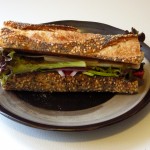About two years ago, I ordered a Rainbow attic stair, so that we could get some usable storage space in our attic. The existing attic access was a tiny hole in the back of a closet, and I could barely fit through it, let alone get in with a box of stuff. So I ordered this drop-down folding ladder. I got this specific one because it was rated for 350 pounds, and all the ones available at the big box stores were only rated for 250. I figured it would be a weekend job to install it. Hah.
First, the handyman whose time Cam got as a Christmas present was sick for several months. And then we went back and forth about where we might be able to install the stair. Eventually, I got up into the attic and crawled around in the insulation, and determined that there’s exactly one place in the whole house where this stair will fit — in the hall outside the bathroom. There was a light installed right where the stair would have to go, so I figured I’d have to move the light. No big deal, right? When I got up there, though, I discovered that it wasn’t just the light I’d have to move; in order to put the stair there, we’d have to cut one of the ceiling joists, and guess which joist the knob-and-tube wiring leading to the bedroom was running along?
If it had been modern wiring, I would have just moved it myself, but knob and tube makes me nervous, so we tried to hire an electrician. There’s a whole other post right there. Suffice it to say that it took over a year to get the wiring moved so we could cut that joist. But eventually that happened, and the handyman was available, and everything was good to go. We got the joist cut, the stairs framed in and bolted into the joists, and expanding foam insulation piped in around the edges so it wasn’t draining hot air out of the house when it was closed, and everything. The only thing remaining to do was to cut the folding ladder to the right length.
This particular ladder is metal, with metal treads welded between the rails. In order to cut the rails to the correct length for our floor (which is very uneven in that hall), I would have had to cut the left rail exactly in the middle of one of the treads, and the right rail just below that same tread. That clearly wasn’t going to work. The installation instructions said that if you had to cut the rails in within an inch of the bottom of a tread, you should cut just above the tread, and then use the adjustment bolts at the top to alter the angle of the whole ladder so that it was long enough again. (There’s no up/down adjustment possible, given the mounting hardware supplied with the ladder. You can adjust how much standoff there is between the ladder and the platform that hinges up and down from the ceiling, but there’s no adjustment in the other dimension. Which is just bad design, if you ask me.)
If I had cut the rails just above the treads, I would have had to angle the ladder so much that the steps would be nowhere near level. And that just seems like an accident waiting to happen. Ladder steps should be level, especially if it’s a ladder you’re going to be going up and down while carrying boxes. There was no adjustment possible with the mounting brackets, but I did notice that the brackets themselves had been moved at least once — there were holes drilled a few inches away from the brackets, with the right spacing to have mounted the brackets there. I figured they must be where you’d install the brackets for one of the other model of stair Rainbow sells, and that I could probably just unscrew the mounting brackets and move them a few inches down, making the cut points on the rails just above that tread without having to adjust the angle of the ladder. So that’s what I did.
I got the mounting brackets moved down three inches, the ladder measured and cut to length, and everything looked good. I’d been a little worried that there didn’t seem to be much “bite” to the bracket mounting screws, but didn’t think much of it. Everything looked good, so I gave it a test. I was three or four steps up when the ladder’s mounting brackets ripped out of the door and the whole ladder slid back into the hall, dumping me on the ground. Luckily, I stayed upright. And when I examined the holes the mounting brackets had ripped out of, I realized why the screws didn’t seem to bite much — the door that they’re mounted to is hollow-core. The only place where it’s solid is at the original mounting points. So when I moved the mounting brackets, I was just screwing them into fiberboard.
What the fuck, Rainbow? How hard would it have been to make that door solid plywood, instead of a solid frame and two crossbars with finished fiberboard facing? Or to provide a mounting bracket that provided adjustment in the other, useful, direction?
This whole thing has been a massive clusterfuck, and now I’m going to have to either fabricate myself a whole new door out of plywood or cut the interior fiberboard facing out and install solid crossbars at the location I need to put the mounting hardware, now that I’ve cut the ladder to length. Or maybe I’ll head up the street to the metal shop and see if they can fabricate me some mounting brackets that don’t suck. Either way, I am heartily sick of this project. Also, my ankle is starting to bruise from where I hit it on something on the way down. Oh, and one of the treads caught on the latch on the way down, and bent both the latch and the tread, so I’m going to have to get a vise and bend the latch back into shape or have the metal shop make me a new one. And while I bent the tread more or less back into shape, I don’t know that it’ll hold as much weight as it used to, so I’m probably going to have to reinforce it with some bar stock.
Longest weekend project ever. *mutter*
(Crossposted from elsewhere.org.)









